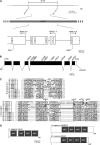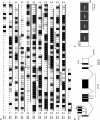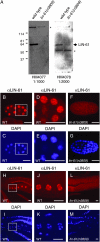LIN-61, one of two Caenorhabditis elegans malignant-brain-tumor-repeat-containing proteins, acts with the DRM and NuRD-like protein complexes in vulval development but not in certain other biological processes
- PMID: 17409073
- PMCID: PMC1893064
- DOI: 10.1534/genetics.106.069633
LIN-61, one of two Caenorhabditis elegans malignant-brain-tumor-repeat-containing proteins, acts with the DRM and NuRD-like protein complexes in vulval development but not in certain other biological processes
Abstract
Vulval development in Caenorhabiditis elegans is inhibited by the redundant functions of the synthetic multivulva (synMuv) genes. At least 26 synMuv genes have been identified, many of which appear to act via transcriptional repression. Here we report the molecular identification of the class B synMuv gene lin-61, which encodes a protein composed of four malignant brain tumor (MBT) repeats. MBT repeats, domains of approximately 100 amino acids, have been found in multiple copies in a number of transcriptional repressors, including Polycomb-group proteins. MBT repeats are important for the transcriptional repression mediated by these proteins and in some cases have been shown to bind modified histones. C. elegans contains one other MBT-repeat-containing protein, MBTR-1. We demonstrate that a deletion allele of mbtr-1 does not cause a synMuv phenotype nor does mbtr-1 appear to act redundantly with or in opposition to lin-61. We further show that lin-61 is phenotypically and biochemically distinct from other class B synMuv genes. Our data indicate that while the class B synMuv genes act together to regulate vulval development, lin-61 functions separately from some class B synMuv proteins in other biological processes.
Figures






Similar articles
-
Some C. elegans class B synthetic multivulva proteins encode a conserved LIN-35 Rb-containing complex distinct from a NuRD-like complex.Proc Natl Acad Sci U S A. 2006 Nov 7;103(45):16782-7. doi: 10.1073/pnas.0608461103. Epub 2006 Oct 30. Proc Natl Acad Sci U S A. 2006. PMID: 17075059 Free PMC article.
-
lin-8, which antagonizes Caenorhabditis elegans Ras-mediated vulval induction, encodes a novel nuclear protein that interacts with the LIN-35 Rb protein.Genetics. 2005 Nov;171(3):1017-31. doi: 10.1534/genetics.104.034173. Epub 2005 Jul 14. Genetics. 2005. PMID: 16020796 Free PMC article.
-
C. elegans Rb, NuRD, and Ras regulate lin-39-mediated cell fusion during vulval fate specification.Curr Biol. 2001 Nov 27;11(23):1874-9. doi: 10.1016/s0960-9822(01)00596-6. Curr Biol. 2001. PMID: 11728311
-
LET-23-mediated signal transduction during Caenorhabditis elegans development.Mol Reprod Dev. 1995 Dec;42(4):523-8. doi: 10.1002/mrd.1080420422. Mol Reprod Dev. 1995. PMID: 8607985 Review.
-
The SynMuv genes of Caenorhabditis elegans in vulval development and beyond.Dev Biol. 2007 Jun 1;306(1):1-9. doi: 10.1016/j.ydbio.2007.03.016. Epub 2007 Mar 20. Dev Biol. 2007. PMID: 17434473 Free PMC article. Review.
Cited by
-
The DREAM complex: master coordinator of cell cycle-dependent gene expression.Nat Rev Cancer. 2013 Aug;13(8):585-95. doi: 10.1038/nrc3556. Epub 2013 Jul 11. Nat Rev Cancer. 2013. PMID: 23842645 Free PMC article. Review.
-
RBPJ/CBF1 interacts with L3MBTL3/MBT1 to promote repression of Notch signaling via histone demethylase KDM1A/LSD1.EMBO J. 2017 Nov 2;36(21):3232-3249. doi: 10.15252/embj.201796525. Epub 2017 Oct 13. EMBO J. 2017. PMID: 29030483 Free PMC article.
-
Decreased SynMuv B gene activity in response to viral infection leads to activation of the antiviral RNAi pathway in C. elegans.PLoS Biol. 2025 Jan 29;23(1):e3002748. doi: 10.1371/journal.pbio.3002748. eCollection 2025 Jan. PLoS Biol. 2025. PMID: 39879188 Free PMC article.
-
H3K9me2/3 binding of the MBT domain protein LIN-61 is essential for Caenorhabditis elegans vulva development.PLoS Genet. 2011 Mar;7(3):e1002017. doi: 10.1371/journal.pgen.1002017. Epub 2011 Mar 17. PLoS Genet. 2011. PMID: 21437264 Free PMC article.
-
Chlamydomonas CHT7 Is Required for an Effective Quiescent State by Regulating Nutrient-Responsive Cell Cycle Gene Expression.Plant Cell. 2020 Apr;32(4):1240-1269. doi: 10.1105/tpc.19.00628. Epub 2020 Jan 30. Plant Cell. 2020. PMID: 32001503 Free PMC article.
References
-
- Andersen, E. C., X. Lu and H. R. Horvitz, 2006. C. elegans ISWI and NURF301 antagonize an Rb-like pathway in the determination of multiple cell fates. Development 133: 2695–2704. - PubMed
-
- Bannister, A. J., P. Zegerman, J. F. Partridge, E. A. Miska, J. O. Thomas et al., 2001. Selective recognition of methylated lysine 9 on histone H3 by the HP1 chromo domain. Nature 410: 120–124. - PubMed
Publication types
MeSH terms
Substances
Associated data
- Actions
Grants and funding
LinkOut - more resources
Full Text Sources
Molecular Biology Databases

